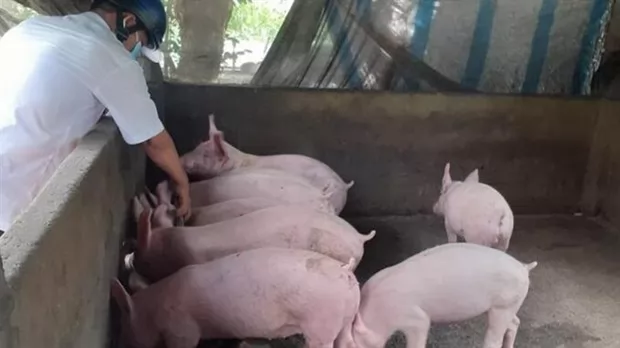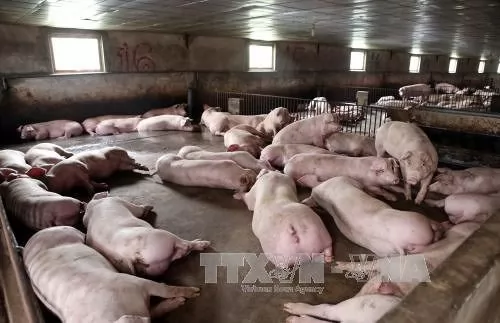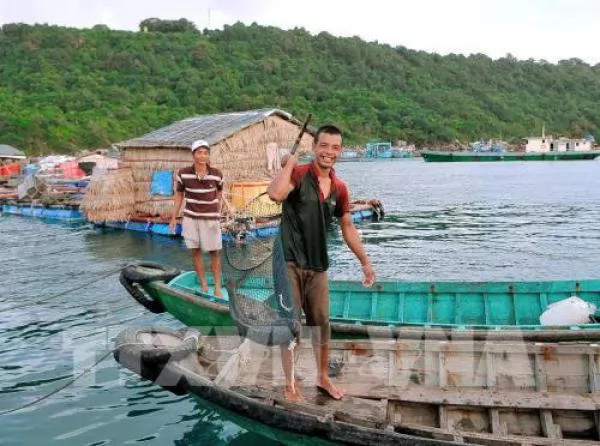Shrimp farmers told to halt polluting practice

Farmers harvest white-legged shrimp in the Mekong Delta. Local farmers were advised not to breed white-legged shrimp in fresh water areas because wastewater from breeding could pollute water sources. — VNA/VNS Photo Hoang Hai
HCM CITY (VNS)— The Directorate of Fisheries and local authorities have told farmers in Cuu Long (Mekong) Delta not to breed white-legged shrimp in fresh water areas as wastewater from breeding could pollute water sources.
White-legged shrimp live in brackish, saline water and are normally bred in coastal areas. To breed the shrimp in fresh water areas, farmers have been using bored well water, to which they add salt.
Farmers who have no access to waste treatment have been releasing waste water directly into rivers and canals.
The release of saline waste water in fresh water areas will affect rice production, the Research Institute for Aquaculture No. 2 has said.
Last year, many farmers in the Delta began raising the profitable white-legged shrimp in unzoned areas despite warnings from local authorities.
Farmers earned a profit VND500-700 million (US$23,800 - 33,300) per ha for one crop (bred over 70 to 90 days) of white-legged shrimp last year.
Because of higher yields and prices due to export demand, profits were higher than those from rice cultivation and other aquatic species.
Last year, the country's 600,000ha of black tiger shrimp had an output of 268,000 tonnes, while its 66,000ha of white-legged shrimp yielded 280,000 tonnes, according to the Ministry of Agriculture and Rural Development.
Many farmers in fresh water areas have turned their orchards, rice fields and fresh-water ponds into white-legged shrimp ponds.
As of last month, in the delta's fresh water and salt water areas, farmers had bred more than 1,200ha of white-legged shrimp in unzoned areas, according to the directorate.
White-legged shrimp breeding has developed rapidly in upstream provinces like Dong Thap and An Giang.
In Dong Thap Province, for instance, 57 households in fresh-water areas have bred white-legged shrimp on a total area of more than 64 ha.
Of the 57 households, 14 have harvested white-legged shrimp, with an average yield of 5.6 tonnes per ha. One kilo of 70 shrimp sells for about VND93,000 ($4.4). Most of the households use bored well water to breed shrimp.
The massive exploitation of groundwater to breed white-legged shrimp could deplete this water source, according to the directorate.
In addition, if shrimp disease outbreaks occur in upstream provinces, they could threaten shrimp cultivation in downstream provinces, it said.
Speaking at a seminar held in Dong Thap on May 14, Nguyen Huy Dien, deputy head of the directorate, said the breeding of white-legged shrimp had brought immediate economic benefits because of high yields and prices.
However, the adverse impact will be severe, especially in fresh-water areas, he said.
Dien asked the directorate's Aquaculture Division and other agencies to issue a report on the breeding of white-legged shrimp to the Ministry of Agriculture and Rural Development.
The directorate's Aquaculture Division was asked to propose measures to tighten the management of white-legged shrimp breeding and ban the exploitation of groundwater for breeding the shrimp in fresh-water areas.
Local fisheries sub-departments were also advised to instruct farmers about the long-term impact of breeding white-legged shrimp in fresh-water areas, he said. — VNS
Maybe you are interested

Vietnam needs to promote livestock value chain development
Vietnam should enhance cooperation between State management agencies and commodity associations to jointly build a value chain for Vietnam's livestock industry.

Trà Vinh seeks to revive livestock sector
Viet Nam News | TRÀ VINH — Trà Vinh’s livestock sector experienced one of its worst years in 2017 with the prices of pigs and cattle falling sharply.

Marine aquaculture brings high profits to Kiên Giang farmers
KIÊN GIANG - Breeding marine fish in floating cages has offered high profits for farmers in Kiên Giang Province's coastal areas and islands.





